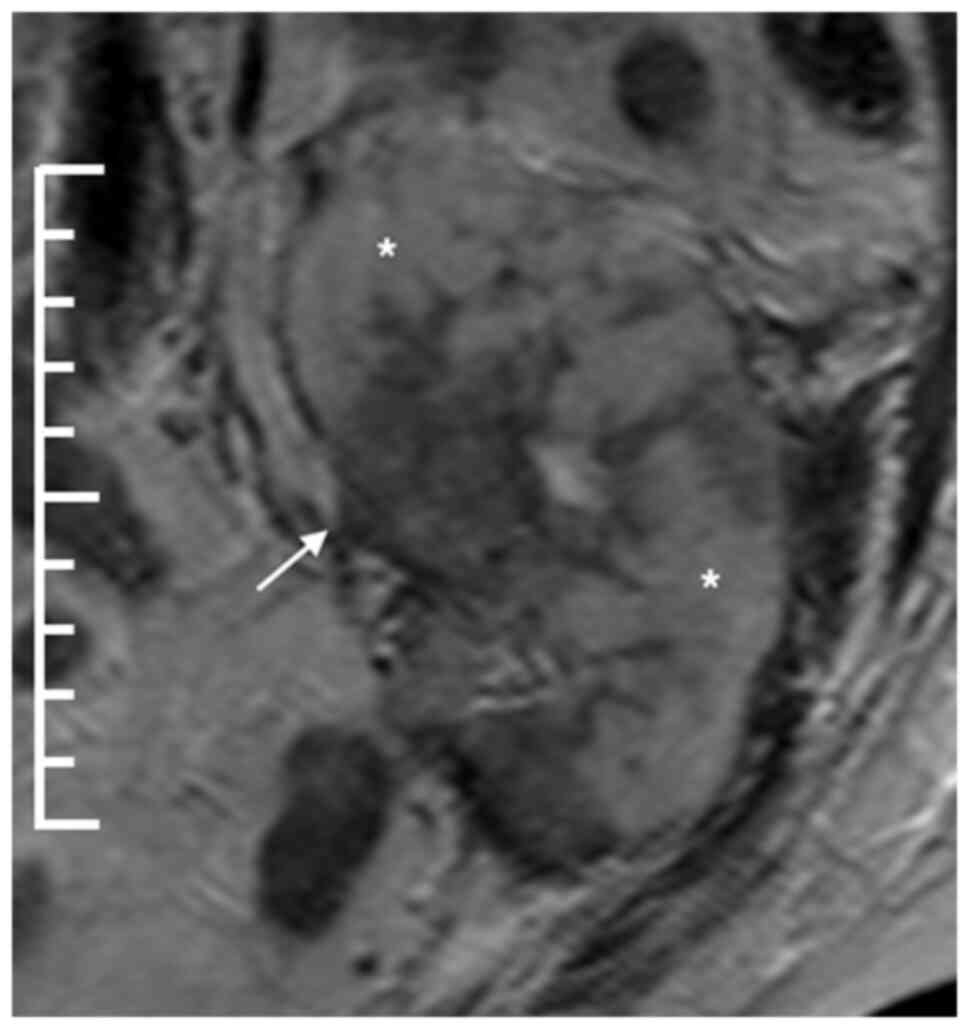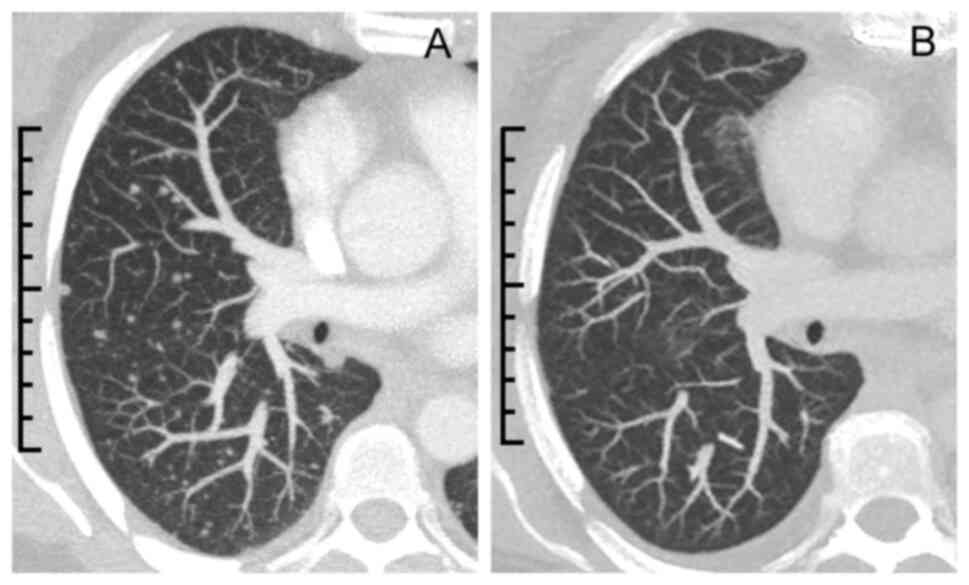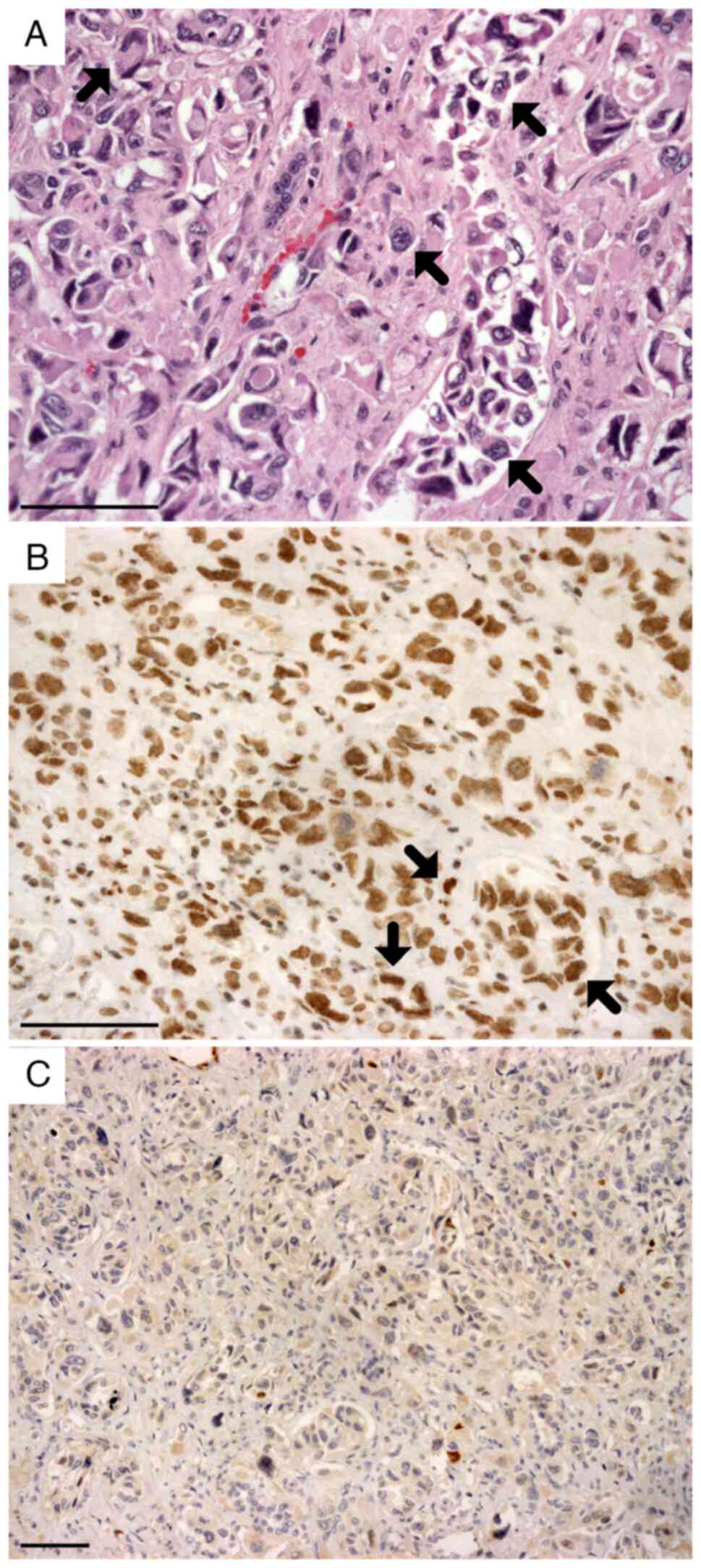Effective treatment of collecting duct carcinoma in a recipient of a kidney transplant: A case report
- Authors:
- Published online on: September 3, 2024 https://doi.org/10.3892/ol.2024.14661
- Article Number: 528
-
Copyright: © Nascimento De Assis et al. This is an open access article distributed under the terms of Creative Commons Attribution License.
Abstract
Introduction
Collecting duct carcinoma (CDC) is a rare disease with a poor prognosis, representing ~1% of kidney tumours worldwide (1–4). A recent study demonstrated a possible origin for CDC in the distal convoluted tubules, which makes CDC biologically distinct from renal cell carcinoma (RCC) and urothelial carcinoma (5). Due to its rarity, there is a lack of information about the treatment and clinical management of CDC; therefore, several approaches are adapted from urothelial carcinoma (2,3). Furthermore, the mortality rate of advanced CDC is high; the 3-year relative survival rate for metastatic disease is ~6% worldwide (5,6).
The present study describes the case of a 36-year-old woman who was diagnosed with allograft CDC 18 months after receiving a deceased-donor kidney transplant. Staging exams revealed multiple pulmonary nodules, and left retroperitoneal and iliac lymphadenopathy. The patient underwent nephrectomy, and chemotherapy with gemcitabine and cisplatin. They achieved a complete radiological response and had a 6-year disease-free survival after completing this chemotherapy protocol.
Case report
A 36-year-old woman with end-stage renal disease (ESRD) of unknown aetiology, undergoing haemodialysis for 2 years, underwent a deceased-donor kidney transplant at the Clinical Hospital of Ribeirão Preto, University of São Paulo (Ribeirão Preto, Brazil) in July 2015, 18 months before the diagnosis of CDC. The donor was a 53-year-old woman, with three HLA mismatches and 29 h cold ischemic time. The induction of immunosuppression was performed with thymoglobulin [anti-thymocyte globulin (rabbit), 6 mg/kg], and was maintained with prednisone (5 mg), mycophenolate sodium (720 mg) and tacrolimus (10 mg). An allograft biopsy was performed due to delayed graft function and cytomegalovirus infection, and it revealed normal renal parenchyma (17 months before the diagnosis of CDC). The patient was treated with ganciclovir (2.5 mg/kg q24 h) for 2 weeks, and laboratory analysis showed creatinine levels of 1.5 mg/dl (normal range, 0.6-1.3 mg/dl), glomerular filtration rate: 46 ml/min/1.73 m2 (chronic kidney disease stage 3T) (7) and normal urinary sediment. In January 2017, the creatinine levels had increased to 3.7 mg/dl, and the patient was admitted in the Clinical Hospital of Ribeirão Preto of University of São Paulo for further investigation. Renal ultrasound demonstrated a diffusely heterogeneous kidney allograft parenchyma and a new biopsy revealed a neoplastic process in the tubules, also with neoplastic interstitial infiltration. Immunohistochemical evaluation of a Bouin-fixed renal biopsy (Appendix S1) showed a positive vimentin cytoplasmic pattern; positive cytokeratin (CK) AE1/AE3; weak positive RCC antigen; doubtful positive CD10; and negative 35BH11, 34BE12, CK7, CK20, paired box gene 8, CD117, HMB45, Melan A, transcription factor E3, CD3, CD20, CD30, desmin, S100, CD31 and integrase interactor 1 (SMARCB1/INI1) (data not shown). Therefore, the result was carcinoma not otherwise specified. Kidney nuclear magnetic resonance imaging showed the transplanted kidney with a diffuse, infiltrative lesion occupying the whole organ with just a few areas of preserved renal parenchyma (Fig. 1). Staging computed tomography (CT) scans revealed multiple pulmonary nodules, and left retroperitoneal and iliac lymphadenopathy (Fig. 2A). The patient underwent allograft nephrectomy and left salpingo-oophorectomy, and was restarted on chronic haemodialysis 1 month after diagnosis. Due to neoplastic involvement of the left common and external iliac arteries, a left iliac-femoral prosthesis was also placed intraoperatively. A histopathological study of the nephrectomy specimen showed malignant epithelial neoplasia with renal cortex and medulla infiltration (Fig. 3A), extending to the perirenal adipose tissue and the pyelocaliceal system, with venous, lymphatic and perineural invasion. The neutral-buffered formalin-fixed nephrectomy specimen immunohistochemical panel exhibited positivity for CK7, CEA, CAM5.2, CK19, OCT3/4 (data not shown) and SMARCB1/INI1 (Fig. 3B). In addition, paired box gene 8, WT1, oestrogen receptor, CD117, CK20 (data not shown) and p63 staining was negative (Fig. 3C). Thus, a diagnosis of kidney allograft CDC was confirmed, mainly due to SMARCB1/INI1 positivity and p63 negativity (Table I) (8,9). The discrepancies in immunohistochemical findings between the renal biopsy and the nephrectomy specimen were potentially attributed to the variance in fixatives employed between the samples. While the renal biopsy was fixed in Bouin's solution, the nephrectomy material was fixed in neutral-buffered formalin. Finally, due to metastases in the left lung, ovary, fallopian tube and iliac lymph node, the TNM staging was pT3a pN1 pM1 (10).
For treatment, a chemotherapy regimen with gemcitabine and cisplatin was administered, with each cycle consisting of i) Days 1 and 8: Intravenous gemcitabine 1,000 mg/m2 (full dose), followed 2 h after infusion by 3-h haemodialysis; ii) day 2: Intravenous cisplatin 35 mg/m2 (half dose), followed 1 h after infusion by 3-h haemodialysis; and iii) days 4–8: Subcutaneous filgrastim 300 µg/day. All haemodialysis sessions were performed with a 300 ml/min blood flow and a FX80 high-flow dialyzer (Fresenius Medical Care). Cisplatin was chosen instead of carboplatin to reduce haematological toxicity, and its dose was reduced according to creatinine clearance. The patient was treated at the Clinical Hospital of Ribeirão Preto, University of São Paulo, which was entirely insured by the public health system, without access to tyrosine kinase inhibitors or immunotherapy.
The patient underwent six cycles of the described chemotherapy protocol, with 4-week intervals. During therapy, there were two episodes of neutropenia-grades 2 and 3 according to the National Cancer Institute Common Terminology Criteria for Adverse Events (11)-without clinical repercussions, and one episode of haemodialysis catheter-related bloodstream infection, which was successfully treated with vancomycin (1 g) and ceftazidime (2 g) intravenously, both three times per week. The last chemotherapy session was performed 9 months after CDC diagnosis. The patient achieved a complete radiological response, with remission of lung lesions on chest CT (Fig. 2B).
Since completing the chemotherapy protocol, the patient has had 6 years of disease-free survival. They remain under clinical-radiological follow-up at the oncology outpatient clinic, and continue to be treated with haemodialysis.
Discussion
CDC is a type of non-clear cell carcinoma with a high mortality rate, with 50.3% of global cases being diagnosed as stage IV disease (5). Furthermore, the overall median survival time is <12 months (5). The appropriate treatment for CDC is still unclear, and most knowledge is acquired through case reports (4). Due to its aggressive behaviour, treatment includes radical surgical techniques, and most patients undergo nephrectomy plus lymphadenectomy for diagnosis and cytoreductive therapy (5).
Conventional adjuvant chemotherapy with gemcitabine and cisplatin was adopted in the present case following guidance from the GETUG group phase II study (3). There are other regimens used for urothelial carcinoma that are used for CDC, such as paclitaxel/carboplatin; methotrexate/vinblastine/doxorubicin/cisplatin; and mitomycin/cisplatin (1,4). Although not well established, new and more specific therapies have been reported, such as nivolumab, sutinib, sorafenib, everolimus, temsirolimus and cabozantinib (1,4,12). However, the combination of gemcitabine and cisplatin remains as first-line therapy, given its efficacy and better tolerability and safety levels (3,13).
Gemcitabine is a pyrimidine nucleoside analogue. When submitted to intracellular phosphorylation, it generates a cytotoxic metabolite that prevents DNA synthesis and promotes cell death (14–16). The drug is mainly excreted by the kidneys after rapid conversion into 2′,2′-difluorodeoxyuridine (dFdU) by tissue and plasma cytidine deaminase enzymes, 60–90 min after infusion (12,17). dFdU is classically considered a non-toxic metabolite; however, it has been suggested that its elevated serum levels in chronic kidney disease (CKD) can lead to toxicity (14–16). In a previous case report, serial serum measurements of gemcitabine and dFdU have demonstrated adequate removal with haemodialysis [blood flow of 200 ml/min, F7 polysulfone low-flux membrane (Fresenius Medical Care); 3.5-h session], with dFdU clearance of 148 ml/min, a half-life of 3.9 h and a 50% reduction in plasma levels (15). Satisfactory experiences with 800–1,000 mg/m2 gemcitabine followed by haemodialysis after 24 h have been reported (16). In addition, other cases have used a full dose of gemcitabine (1,000 mg/m2), but with earlier haemodialysis, between 6 and 12 h after chemotherapy (15,17).
Cisplatin is a potent antineoplastic medication used to treat several types of solid tumour; ~90% of the drug binds to plasma proteins, with the free fraction being responsible for toxic effects (12,18). Therefore, cisplatin clearance is biphasic and consists of an initial phase of rapid urinary excretion of the free fraction, with a half-life of 20–45 min, followed by a long phase of excretion of the conjugated fraction, with a half-life of 5 days (12,18). Usually, the dose of cisplatin is reduced by 50% (35 mg/m2) in patients undergoing dialysis (19). Haemodialysis performed 1 h after cisplatin infusion can cause its rapid clearance and reduce undesirable myelotoxicity; this phenomenon can be explained by early drug extraction prior to its massive protein conjugation, that is, during the first phase of excretion (18).
A 2013 case series in Taiwan revealed successful chemo-therapy treatment with a reduced dose of gemcitabine (600 mg/m2 biweekly) and cisplatin (30 mg/m2 weekly) in patients with CKD and urothelial, bladder, pancreatic, and non-small cell lung cancer (14). The authors chose to reduce the gemcitabine dose after their own negative experiences with myelotoxicity and hepatotoxicity; however, unlike other case reports that performed haemodialysis sooner (15,17), these authors performed haemodialysis 24 h after chemotherapy infusion (14). In a 2016 Japanese study (12), which influenced the present case report, full-dose gemcitabine (1,000 mg/m2) and half-dose cisplatin (35 mg/m2) were prescribed for the treatment of metastatic urothelial carcinoma. A 2-h interval was set between the end of gemcitabine infusion and the beginning of 3-h haemodialysis, considering that all of the drug would have already been converted into dFdU by cytidine deaminases. Therefore, gemcitabine pharmacokinetics would reflect what occurs in patients with normal renal function. Furthermore, cisplatin infusion was performed 1 h before the beginning of 3-h haemodialysis, as reported by previous studies (12,18).
In the present case, the patient achieved a complete radiological response. The thorax imaging findings could be due to inflammation or infection because they were nonspecific. However, the imaging findings were considered pulmonary metastasis (multiple bilateral nodules with soft tissue density) due to the clinical correlation, considering the presence of a neoplasm and the absence of symptomatic lung infections. In addition, the appearance of nodules during the course of the neoplasm and their progressive reduction during chemotherapy treatment corroborates the hypothesis of pulmonary metastases.
In conclusion, in the present case report, the success of chemotherapy with gemcitabine and cisplatin was demonstrated in a metastatic renal allograft CDC in a patient with ESRD. A full dose of gemcitabine (1,000 mg/m2), followed by haemodialysis after 2 h, and half a dose of cisplatin (35 mg/m2), followed by haemodialysis after 1 h, provided a complete response to chemotherapy, with low side effects and no recurrence of the disease 6 years after the end of treatment.
Supplementary Material
Supporting Data
Acknowledgements
Not applicable.
Funding
This study was financed in part by the Coordenação de Aperfeiçoamento de Pessoal de Nível Superior-Brasil (CAPES) (Finance Code 001).
Availability of data and materials
The data generated in the present study may be requested from the corresponding author.
Authors' contributions
TCFNA drafted the original manuscript. TCFNA, MMN, LR and EAR contributed substantially to study conception and design, as well as data acquisition and interpretation. BTMP and VFM collected and analysed the anatomopathological and medical imaging data. FNS was the oncologist who treated the patient, and collected and analysed data from the literature to decide on the patient's treatment. EAR, MMN and TCFNA confirm the authenticity of all the raw data. All authors reviewed the manuscript draft and revised it critically for intellectual content. All authors read and approved the final version of the manuscript.
Ethics approval and consent to participate
The present study was approved by the Medical Ethics Committee of Ribeirão Preto Medical School (approval no. 75746623.6.0000.5440; Ribeirão Preto, Brazil). Written informed consent was obtained from the patient and this study was performed in accordance with The Declaration of Helsinki and according to the Medical Ethics Committee of Ribeirão Preto Medical School.
Patient consent for publication
The patient provided written informed consent for publication.
Competing interests
The authors declare that they have no competing interests.
References
|
Mennitto A, Verzoni E, Peverelli G, Alessi A and Procopio G: Management of metastatic collecting duct carcinoma: An encouraging result in a patient treated with cabozantinib. Clin Genitourin Cancer. 16:e521–e523. 2018. View Article : Google Scholar : PubMed/NCBI | |
|
Orsola A, Trias I, Raventós CX, Español I, Cecchini L and Orsola I: Renal collecting (Bellini) duct carcinoma displays similar characteristics to upper tract urothelial cell carcinoma. Urology. 65:49–54. 2005. View Article : Google Scholar : PubMed/NCBI | |
|
Oudard S, Banu E, Vieillefond A, Fournier L, Priou F, Medioni J, Banu A, Duclos B, Rolland F, Escudier B, et al: Prospective multicenter phase II study of gemcitabine plus platinum salt for metastatic collecting duct carcinoma: Results of a GETUG (Groupe d'Etudes des Tumeurs Uro-Génitales) study. J Urol. 177:1698–1702. 2007. View Article : Google Scholar : PubMed/NCBI | |
|
Yin M, Wang W, Rosenberg J, Kaag M, Joshi M, Holder S, Tuanquin L and Drabick JJ: Targeted therapy in collecting duct carcinoma of the kidney: A case report and literature review. Clin Genitourin Cancer. 14:e203–e236. 2016. View Article : Google Scholar : PubMed/NCBI | |
|
Suarez C, Marmolejo D, Valdivia A, Morales-Barrera R, Gonzalez M, Mateo J, Semidey ME, Lorente D, Trilla E and Carles J: Update in collecting duct carcinoma: Current aspects of the clinical and molecular characterization of an orphan disease. Front Oncol. 12:9701992022. View Article : Google Scholar : PubMed/NCBI | |
|
Pepek J, Johnstone P and Jani A: Influence of demographic factors on outcome of collecting duct carcinoma: A surveillance, epidemiology, and end results (SEER) database analysis. Clin Genitourin Cancer. 7:E24–E27. 2009. View Article : Google Scholar : PubMed/NCBI | |
|
Chapman JR: The KDIGO clinical practice guidelines for the care of kidney transplant recipients. Transplantation. 89:644–645. 2010. View Article : Google Scholar : PubMed/NCBI | |
|
Truong LD and Shen SS: Immunohistochemical diagnosis of renal neoplasms. Arch Pathol Lab Med. 135:92–109. 2011. View Article : Google Scholar : PubMed/NCBI | |
|
Carvalho JC, Thomas DG, Mchugh JB, Shah RB and Kunju LP: P63, CK7, PAX8 and INI-1: An optimal immunohistochemical panel to distinguish poorly differentiated urothelial cell carcinoma from high-grade tumours of the renal collecting system. Histopathology. 60:597–608. 2012. View Article : Google Scholar : PubMed/NCBI | |
|
Rini B, McKiernan J and Chang S: Kidney. Amin M: AJCC Cancer Staging Manual. 8th edition. New York: Springer; pp. pp7392017 | |
|
U.S. Department of Health and Human Services, . Common Terminology Criteria for Adverse Events (CTCAE) Version 5.0. November 27–2017. | |
|
Rimar KJ, Meeks JJ and Kuzel TM: Anti-programmed death receptor 1 blockade induces clinical response in a patient with metastatic collecting duct carcinoma. Clin Genitourin Cancer. 14:e431–e434. 2016. View Article : Google Scholar : PubMed/NCBI | |
|
Ezaki T, Matsumoto K, Morita S, Shinoda K, Mizuno R, Kikuchi E and Oya M: A case of gemcitabine and cisplatin chemotherapy in a patient with metastatic urothelial carcinoma receiving hemodialysis. Clin Genitourin Cancer. 14:e413–e416. 2016. View Article : Google Scholar : PubMed/NCBI | |
|
Chang PY, Dai MS, Ho CL and Yao NS: Administration of gemcitabine and cisplatin in cancer patients with renal failure under hemodialysis. J BUON. 18:1058–1061. 2013.PubMed/NCBI | |
|
Kiani A, Köhne CH, Franz T, Passauer J, Haufe T, Gross P, Ehninger G and Schleyer E: Pharmacokinetics of gemcitabine in a patient with end-stage renal disease: Effective clearance of its main metabolite by standard hemodialysis treatment. Cancer Chemother Pharmacol. 51:266–270. 2003. View Article : Google Scholar : PubMed/NCBI | |
|
Masumori N, Kunishima Y, Hirobe M, Takeuchi M, Takayanagi A, Tsukamoto T and Itoh T: Measurement of plasma concentration of gemcitabine and its metabolite dFdU in hemodialysis patients with advanced urothelial cancer. Jpn J Clin Oncol. 38:182–185. 2008. View Article : Google Scholar : PubMed/NCBI | |
|
Janus N, Thariat J, Boulanger H, Deray G and Launay-Vacher V: Proposal for dosage adjustment and timing of chemotherapy in hemodialyzed patients. Ann Oncol. 21:1395–403. 2010. View Article : Google Scholar : PubMed/NCBI | |
|
Zahra MA, Taylor A, Mould G, Coles C, Crawford R and Tan LT: Concurrent weekly cisplatin chemotherapy and radiotherapy in a haemodialysis patient with locally advanced cervix cancer. Clin Oncol. 20:6–11. 2008. View Article : Google Scholar | |
|
Horie S, Oya M, Nangaku M, Yasuda Y, Komatsu Y, Yanagita M, Kitagawa Y, Kuwano H, Nishiyama H, Ishioka C, et al: Guidelines for treatment of renal injury during cancer chemotherapy 2016. Clin Exp Nephrol. 22:210–244. 2018. View Article : Google Scholar : PubMed/NCBI |












